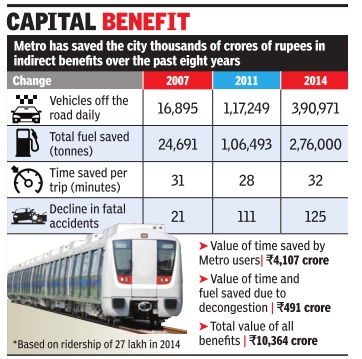Delhi: Metro rail
This is a collection of articles archived for the excellence of their content. |
Contents |
2002-2016: Growth, as well as ageing
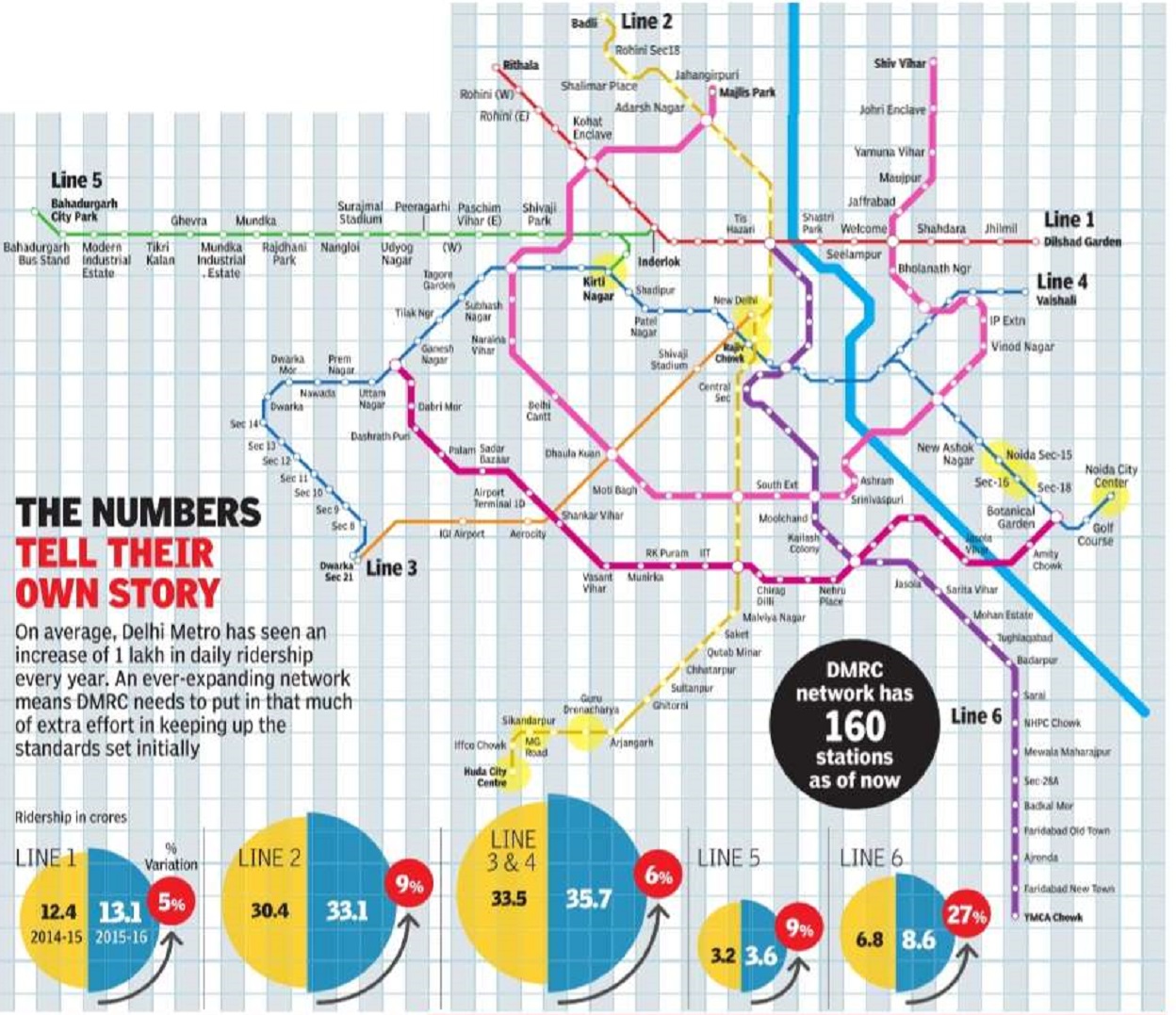
The Times of India

The Times of India
Rumu Banerjee, Under strain, Metro plans to beat the rush, Sep 18 2016 : The Times of India
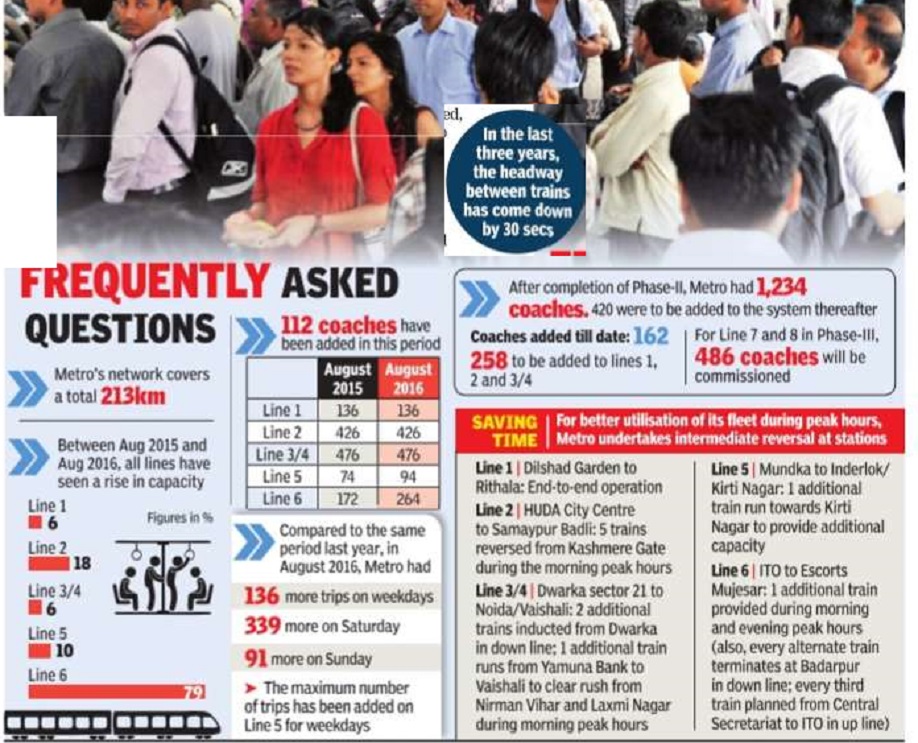
The Times of India
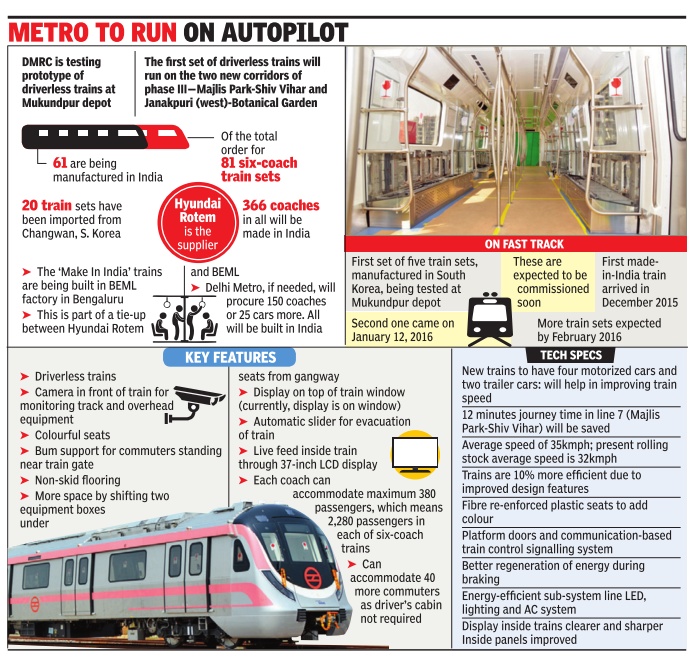
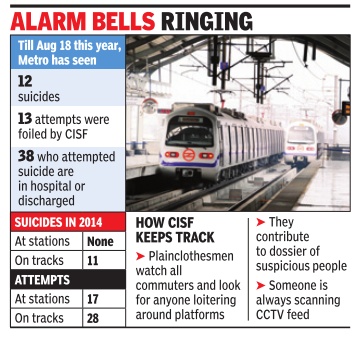

Over 14 years, Metro has changed the way Delhiites travel. But with a massive rise in passenger count, DMRC is taking its reinvention seriously
With passengers having risen from a mere lakh in 2002 to over 27 lakh now, and with two new corridors to open in 2017, the urban train system is straining to maintain the standards with which it began operations.
The wear and tear of 14 years is quite visible: trains break down more often now, the overhead electrification system regularly gets disrupted and even outages halt the services. Outside the stations, autorickshaws, e-rickshaws, buses and cars vie for space, crowding out the commuters. Inside the stations, it's no better. The passenger count at major stations such as Rajiv Chowk, Chandni Chowk, New Delhi, HUDA City Centre and GTB Nagar is between 50,000 and 80,000 every day . Not surprisingly, Delhi Metro has had to induct more marshals or `customer facilitation agents' -400 at around 20 busy stations -in the past year.
But the Delhi Metro Rail Corporation (DMRC) is not sitting idly watching this chaos unfold. It does have plans to streamline the system. For one, the company is reconfiguring the stations. Says Sharat Sharma, director (operations): “Nine stations on Line 2 and Line 3 are being been remodelled for better passenger convenience. This includes shifting and relocation of stairs, ticket counters and exitentry gates to ease congestion.“ The nine stations are HUDA City Centre, Rajiv Chowk, New Delhi, Kirti Nagar, Guru Dronacharya, MG Road and Noida Sector 15, Noida Sector 16 and Noida City Centre.
At Rajiv Chowk, for instance, the Viewers' Gallery, shut all these years to commuters, has been made accessible to them to enable easy passage to either platforms there. “We saw that almost 35,000 passengers entered the station from Gates 5 to 8 and crossed the bridge to get to the other platform. The opening up of the Viewers' Gallery allows better distribution of passenger flow,“ explains Sharma.
At HUDA City Centre, Chandni Chowk and New Delhi, the ticket counters and automated fare collection gates were increased or relocated to create space for passengers.The points where CISF frisked commuters were similarly shifted. The operations director says that to ensure hassle-free passenger services, 171 new token vending machines were put up at major stations, while around 180 new fare collection gates have been erected at busy stations for the convenience of passengers making an entry or an exit.
The overcrowding can often result in accidents. In 2014-15, 71 passengers jumped on to or fell on the tracks. And while this figure slid to 35 in 2015-16, passenger safety remains a big concern. To address this, DMRC plans to install platform screen doors at Central Secretariat, Rajiv Chowk, New Delhi, Chawri Bazar, Chandni Chowk and Kashmere Gate. The restraining screens will not only prevent accidental falls and deter suicide attempts, but also enable better crowd management. “The doors will enable optimum utilisation of the platform space,“ assures a DMRC official.
Ranked 2nd among 18 international metro systems
Delhi Metro ranked 2nd among 18 international metro systems
PTI | Sep 28, 2014
NEW DELHI: Delhi Metro has been ranked second among 18 international Metro systems in terms of overall customer satisfaction in an online customer survey.
According to a DMRC official, in the survey conducted among the commuters of those Metro systems by Global Metro Benchmarking Groups 'NOVA' and 'CoMET', Delhi Metro along with London DLR and Bangkok were the best three performers in the 'Net Promoters Score' (NPS) category.
Under this category the survey analysed the likelihood of customers recommending the service to others on the basis of their satisfaction.
More than 41,000 respondents gave their feedback worldwide in this survey conducted online through the websites and social media links of 18 major Metros of the world from April 28th to May 25th earlier this year. The Metro systems that participated in this survey apart from Delhi Metro were Hong Kong MTR, London Underground, Metro De Madrid, Paris RATP, Metro De Sandiago, Singapore SMRT, Barcelona TMB, Brussels STIB, Bangkok BMCL, London DLR, Istanbul Ulasim, Kualalumpur Rapid PL, Metropolitano De Lisboa, Montreal STM, Newcastle Nexus, Metro Rio and Toronto TTC.
The NPS is calculated by the percentage of promoters minus the percentage of detractors (P-D = NPS).
When asked to list out the three top priority areas, the respondents from Delhi along with 17 other Metros listed as 'availability' as the most important requirement. Only New Castle and Hong Kong selected 'Reliability' as their most important area.
"Delhi Metro commuters rated reliability and crowding as the other two important priority areas," the official said.
The survey was conducted as per the 'European Norm 13816' and the areas covered were availability, accessibility, ease of use, information prior to travel, information during travel, reliability, customer care, comfort, crowding, and security.
DMRC is a member of the NOVA group of Metros which is a benchmarking community comprising of 17 metro systems (small and medium size metros) from around the world.
It provides a platform to share experiences, ideas and good practices followed by member Metro systems across the world. It also helps in evaluating the performance of Metro systems by studying their key performance indicators. The forum is co-ordinated by the Rail Transport Strategic Centre (RTSC) of Imperial College, London.
This year, DMRC hosted the NOVA Phase-17 Management Meeting in New Delhi from September 24-26. The meeting was attended by 11 NOVA member Metros including DMRC and two Indian observers' Metros (Bangalore Metro and Chennai Metro).
DMRC will be elevated to CoMET (Community of Metros) Group of Metros. The CoMET is a group of 16 of the world's largest Metros. To qualify for becoming a member of CoMET, the average ridership should be above 20 lakh and the city should be the primary city of country.
Economic benefits: 2007-2012
Dec 25 2014
Delhi Metro rides high and is keeping 3.9 lakh vehicles off roads
The Delhi Metro Rail Corporation (DMRC), that celebrated 12 years of its operation claimed to have kept nearly 3.9 lakh vehicles off roads in 2014.The head of DMRC, Mangu Singh, said the Metro helped save Rs 10,364 crore in fuel, time saved in commuting and other benefits. It also helped reduce air pollution and accidents. The figures, revised and calculated by Central Road Research Institute (CRRI), quantify the benefits of the 190kmlong Delhi Metro network. The numbers are certainly eyeopener. According to CRRI, the Metro also saved 32 minutes on every trip taken by a commuter. This is a jump from the 28 minutes saved in 2011.
Delhi Metro saved Rs 1,972 crore in fuel conserved. In absolute terms, it saved 2.7 lakh tonnes of fuel in 2014 as against 1.06 lakh tonnes in 2011. The savings in cost of vehicle capital and operation was Rs 2,617 crore while indi vidually, Delhi Metro commuters saved Rs 4,107 crore in terms of money from time saved.
That's not all. The Delhi Metro also impacted the accident figures in the city. The annual reduction in fatal accidents was 125 in 2014 as against 111 and 21 in 2011 and 2007 respectively when Phase II of the network was constructed. The annual reduction in terms of accidents per se was 937 in 2014 as against 591 and 93 in 2011 and 2007 respectively .
The amount from time and fuel saved due to decongestion resulting from Delhi Metro is Rs 491 crore. Savings from reduction in pollution due to Metro was Rs 489 crore. In fact, the total savings from all the benefits is Rs 10, 364 crore in 2014. All the figures are based on a daily ridership of 27 lakh.
DMRC also introduced a number of features this year.Besides the opening of two stations Janpath and Mandi House -the Delhi Metro also converted 11 trains into eightcoach trains, maintained an average punctuality percentage of 99.88% and increased the ridership by over 20,000 passengers from last year.
The ‘lines’
Heritage corridor line (Central Secretariat-Kashmere Gate)
The Times of India, June 8, 2016
Rumu Banerjee
With an available manoeuvrability of only 78cm, building a tunnel may not seem like the easiest of things. Yet, that's what the Delhi Metro has done at the upcoming phase III station at Kashmere Gate. The tunnels for the up and down line for the Heritage corridor--from Central Secretariat to Kashmere Gate--have been constructed between the pillars of the existing elevated Red line. Stationed less than 10m apart, the pillars acted as the “bookends“ for the tunnels, which needed to go diagonally ( across the Heritage line coming from Red Fort. Said DMRC t spokesman Anuj Dayal, “The i space was minimal for the tunp nels as the pillars are further enclosed in pier caps. The space between the outer perimeter of the tunnel and the pier cap is 780-800 millimetres at both the up and down line.“
Engineers who undertook the construction admit that the task was fraught with risk, not to mention heightened requirement for precision construction. “The entire stretch, where the tunnel crosses the pillars, is only 20m but the task took 15 days to perform,“ said a Delhi Metro official.
That's not the only engineering marvel DMRC has achieved on the corridor. With two lines already criss-crossing at the Kashmere Gate station -the Red line (Rithala to Dilshad Garden) and the Yellow line (Huda City Centre to Samaypur Badli) -the Heritage line station had to be accommodated in the space left between the platforms of these two lines. “It was a close, confined space, but we wanted to utilise every inch.So the platform for the Heritage line had to be built in a tapered way . As a result, the platform is 14m on the south end--on the Red Fort side--and only 8.5m on the north side,“ added Dayal.
The continuous flow of surface traffic--the station abuts the Kashmere Gate ISBT and a major arterial road--ensured that disruptions had to be kept to the minimum, say officials.“The presence of ASI monuments, especially the wall of the Kashmere Gate, is right along the station. So we had to constantly monitor the work,“ said Dayal.
The Kashmere Gate wall, incidentally , is right above the tunnel of the Heritage line, which goes 11m below. DMRC had to get special clearance from the National Monuments Authority for the station work.
Located 19m below ground, the new station may not be the deepest--Hauz Khas Metro station has that distinction--but it's certainly the only station in the Metro network that will have three interchanges. The ridership of the Kashmere Gate station in phase III is supposed to outstrip the Rajiv Chowk station, with an expected footfall of 5.5 lakh per day .
Interestingly, the road above the station, which has been diverted at present, will be relaid, with the same soil that had been taken out. “Over 1 lakh cubic metre of soil has been taken out from the station site during the construction. Almost 30% of this will be brought back to re-lay the road once the construction is over,“ Dayal added.
Fire safety norms
2011-16: 25 stations flout norms
The Times of India, June 3, 2016
Himanshi Dhawan
At least 25 Delhi Metro stations flouted fire safety norms for periods ranging from one month to two years over the past five years.This includes high traffic stations like HUDA City Centre, Nehru Place, Dhaula Kuan, Okhla, Tilak Nagar, Moolchand and Kailash Colony .Information accessed through RTI shows that some like Vaishali station on Line 4 and Kirti Nagar on Line 5 do not have a fire no-objection certificate even now. The information was given by DMRC to Gurgaon-based IT manager Sudhir Yadav. DMRC has admitted that it failed to get a fire NOC for 32 stations. Some lapses were only for a few days. However, amongst those stations that did not get a fire NOC for a significantly long period of time include Tilak Nagar which did not have fire clearance from 2014 till February this year. HUDA city centre did not have a fire NOC for a year between May 2011 to May 2012 and then again for two years between February 2014 to January 2016 indicating a casual attitude towards safety standards.
Some stations like Tugh laqabad did not have a fire NOC for 21months, Sivaji stadium did not have clearances for 16 months while others like Kailash Colony , Okhla and Nehru Place had no fire checks for 15 months between 2013-2014. Lajpat Nagar, Moolchand stations went unaccounted for a year, while New Delhi station on the airport line did not have a fire NOC for 10 months. “When Delhi govern ment introduced odd even scheme, I preferred to use the Metro instead of taking cab or bus. But I was worried the safety measures taken because of how crowded the stations are. I filed a RTI application asking for the fire NOC of all the Metro stations. I was shocked when I received the response, Yadav said.
